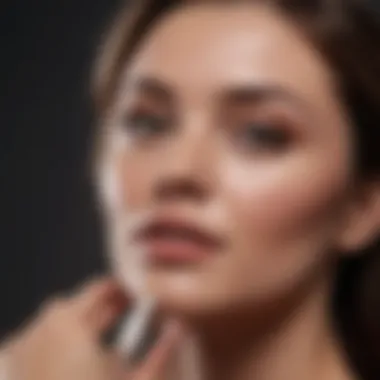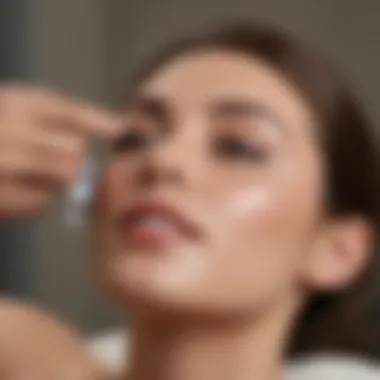Comprehensive Guide to Treating Bikini Razor Bumps


Intro
Razor bumps, particularly in the bikini area, are a common concern for individuals seeking a smooth, well-groomed appearance. Understanding the causes of razor bumps is crucial for effective prevention and treatment. These bumps often arise due to the hair curling back into the skin after shaving, leading to inflammation and irritation. In this guide, we will explore various strategies to alleviate and prevent these bumps, emphasizing skincare routines and product recommendations tailored for sensitive areas.
Beauty Tips and Tricks
Skincare Routine Tips
To tackle razor bumps effectively, it is essential to adopt a comprehensive skincare routine. Here are key steps to consider:
- Exfoliation: Gently exfoliate the bikini area before shaving. This helps remove dead skin cells and reduces the likelihood of hair becoming trapped.
- Hydration: Keep the skin moisturized. Using a fragrance-free lotion can soothe and protect sensitive skin.
- Post-Shave Care: Apply a soothing gel or cream with ingredients like aloe vera or chamomile to calm irritation post-shave.
Haircare Hacks
While focusing on the bikini area, do not overlook general hair care which plays a role in overall skin health:
- Trim Before Shaving: If hair is long, consider trimming it to a manageable length before shaving. This minimizes tugging.
- Shave in the Right Direction: Always shave with the hair growth to reduce irritation and prevent razor bumps.
Makeup Application Techniques
Though makeup application is less relevant in the bikini area, some techniques can help cover any redness or irritation:
- Light Concealer: Use a lightweight, non-comedogenic concealer for any visible bumps.
- Set with Powder: A translucent powder may help absorb oil and reduce shine.
Product Reviews
Skincare Product Reviews
Here are some effective products designed specifically for post-shave care:
- Burt’s Bees Aloe & Coconut Oil After-Shave Cream: Excellent for soothing skin. Its natural ingredients make it gentle and effective.
- CeraVe Hydrating Body Wash: A hydrating wash helps repair your skin barrier while cleansing.
Makeup Product Reviews
When addressing the appearance of razor bumps, some makeup products can help:
- Maybelline Fit Me Concealer: Provides good coverage without clogging pores, ideal for sensitive skin.
- Clinique Beyond Perfecting Foundation: Lightweight coverage that doesn’t aggravate the skin.
Haircare Product Reviews
Products that promote healthy hair growth may also assist in reducing bumps:
- Kérastase Specifique Shampoo: Targets flakiness and irritation at the scalp, which can be linked to skin health on the body.
Expert Beauty Advice
Professional Makeup Artist Insights
A professional makeup artist advises focusing on skin prep. "Well-prepped skin is less likely to show irritation. Always hydrate and protect before applying makeup.”
Skincare Specialist Recommendations
Consult skincare specialists for personalized advice. Many recommend incorporating ingredients such as salicylic acid or glycolic acid in your routine to reduce bumps.
Hair Stylist Tips
Hair stylists suggest regular trimming and using sharp, clean razors. They emphasize the importance of having clean tools to avoid skin issues.
Epilogue
Razor bumps in the bikini area can be bothersome, but adopting a systematic approach can alleviate and prevent these irritations. By incorporating effective skincare routines and choosing appropriate products, individuals can achieve smoother skin. Always consult with professionals for tailored guidance, enhancing your overall skincare practice.


Understanding Razor Bumps
Razor bumps are a common concern for individuals who remove hair in sensitive areas, including the bikini region. Understanding this issue is essential for effective management and prevention. Razor bumps, scientifically known as pseudofolliculitis barbae, occur when hair grows back into the skin rather than outward. This condition can lead to irritation, inflammation, and discomfort, which can significantly affect one’s self-esteem and skin health.
Some benefits of grasping the nuances of razor bumps include the ability to identify symptoms early, adopt preventative strategies, and select suitable treatments. Incorporating education on this topic empowers those who frequently shave to choose appropriate hair removal methods and aftercare, thereby reducing potential adverse effects.
Moreover, understanding the underlying causes of razor bumps can help guide individuals in their shaving practices. Identifying unique skin types and their reactions to various hair removal techniques can lead to more personalized and effective care.
Key Insight: Awareness about razor bumps promotes healthier skin maintenance and contributes to overall confidence during intimate moments.
What Are Razor Bumps?
Razor bumps manifest as small, raised red or dark spots that appear on the skin after shaving. They can be painful or itchy and are more likely to occur in areas where hair follicles are tightly curled. These can develop not only in the bikini area but also on the face and neck. The appearance of these bumps often leads to further irritation and may result in scarring if left untreated.
This condition mainly arises after shaving due to improper techniques or inadequate skin preparation. Recognizing the symptoms can assist individuals in pursuing effective remedies immediately.
Causes of Razor Bumps
Numerous factors contribute to the formation of razor bumps. Understanding these is crucial for preventing them in the future:
- Curly Hair Texture: Curly hair is prone to growing back into the skin, particularly in sensitive areas.
- Improper Shaving Techniques: Not using the correct direction or pressure while shaving can increase the likelihood of bumps.
- Use of Dull Razors: A dull blade requires more pressure, leading to potential irritation and misdirection of hair growth.
- Lack of Skin Preparation: Not cleansing and softening the skin prior to shaving can result in a rougher shave.
- Sensitive Skin: Individuals with sensitive skin types are more susceptible to irritation from shaving products and techniques.
Being aware of these causes allows individuals to adjust their routines, reducing the chances of experiencing razor bumps.
Identifying Razor Bumps vs. Folliculitis
While razor bumps and folliculitis share similar symptoms, distinguishing between the two is vital for appropriate treatment. Razor bumps, as discussed, are often a result of ingrown hairs after shaving. On the other hand, folliculitis is an infection of the hair follicles caused by bacteria, fungi, or irritation. Folliculitis usually presents with pus-filled or yellowish bumps and is often accompanied by more severe itching or tenderness.
To summarize the differences:
- Razor Bumps:
- Folliculitis:
- Caused by ingrown hairs.
- Small, raised red or dark spots.
- Usually itchy or irritated.
- Caused by infections.
- Pus-filled, yellow bumps.
- More severe discomfort and itchiness.
Recognizing these distinctions ensures that one chooses the correct treatment approach, whether it be home remedies for razor bumps or seeking medical intervention for folliculitis.
Prevention Strategies
Preventing razor bumps in the bikini area is essential for maintaining skin health and comfort. These bumps can lead to significant discomfort, and effective prevention strategies enhance the overall shaving experience. Often, the dissatisfaction stemming from razor bumps is avoidable with some simple yet effective steps. Implementing preventive measures not only minimizes the risk of developing these irritations but also supports smoother skin texture and appearance.
Choosing the Right Razor
Selecting the appropriate razor can significantly impact the outcome of your shaving experience. A high-quality razor designed specifically for sensitive areas will reduce irritation and prevent razor bumps. Look for a razor with multiple blades, as this can provide a closer shave while minimizing the pressure needed. Additionally, consider options with a pivoting head, which easily adapts to the contours of the bikini area. Razors with moisturizing strips may also enhance glide and reduce friction.
Preparing the Skin Before Shaving
Proper preparation of the skin before shaving is critical. Start by gently cleansing the area with a mild soap. This step removes any dirt or oils that may hinder the razor's efficiency. After cleansing, exfoliate the skin lightly. This can be done using a soft washcloth or an exfoliating scrub. Exfoliation aids in removing dead skin cells, helping to prevent ingrown hairs that often accompany razor bumps. Always hydrate the skin before shaving, using a suitable shaving gel or cream, which helps in softening the hair and creating a protective barrier. This process is vital for achieving a smoother shave and reducing irritation.
Proper Shaving Techniques
Employing proper shaving techniques is essential for minimizing razor bumps. Firstly, always shave in the direction of hair growth. Shaving against the grain may seem tempting for a closer shave, but it increases the likelihood of irritation and ingrown hairs. Use light, gentle strokes instead of pressing hard against the skin. This reduces the chance of cutting the hair too short or causing nicks. Periodically rinse the razor during shaving to remove hair and shaving cream build-up, maintaining razor efficiency.
Post-Shaving Care
After shaving, taking proper care of the skin is crucial for preventing razor bumps. Rinse the area with cool water to soothe and calm the skin. Following this, apply a fragrance-free soothing lotion or an aloe vera gel that provides hydration without clogging pores. Avoid products with alcohol, as they can cause excessive dryness and irritation. Regular hydration and the use of a good moisturizer will strengthen the skin's barrier, making it less prone to bumps and irritation. For added protection, consider applying a thin layer of a non-comedogenic lotion to maintain skin moisture without risking breakouts.
Treatment Options for Razor Bumps
Razor bumps in the bikini area can cause discomfort and self-consciousness for many individuals. Understanding the treatment options is crucial for effective management. The goal of treating razor bumps is to alleviate irritation, reduce inflammation, and promote healing. It is important to explore various approaches, as solutions may vary based on individual skin types and sensitivity levels. By employing both over-the-counter and natural remedies, along with knowing when to consult professionals, one can effectively tackle this common issue. Let's examine these treatment options in detail.


Over-the-Counter Remedies
Many effective over-the-counter products can reduce symptoms associated with razor bumps. These typically contain ingredients designed to soothe irritation and prevent further inflammation. Here are some commonly used options:
- Hydrocortisone Cream: This anti-inflammatory cream can help lessen redness and swelling. It should be applied sparingly to affected areas.
- Salicylic Acid: Known for its exfoliating properties, salicylic acid helps remove dead skin cells, thereby reducing the chance of hair follicles becoming clogged.
- Aloe Vera Gel: This natural remedy provides moisture and cooling effects on the skin. It can also promote healing and lighten dark spots.
- Witch Hazel: With its astringent properties, witch hazel can minimize inflammation and help calm the skin.
It is advisable to read product labels carefully and perform a patch test, especially if your skin is sensitive.
Natural Treatments
Natural treatments for razor bumps often appeal to those looking for gentler options. These can be beneficial for individuals concerned about harsh chemicals. Here are some effective natural remedies:
- Tea Tree Oil: Known for its antibacterial properties, tea tree oil can help prevent infection and reduce inflammation. Mix with a carrier oil before applying.
- Apple Cider Vinegar: Its anti-inflammatory properties can help balance skin's pH levels and reduce bumps. Dilute with water before application to avoid irritation.
- Honey: A natural humectant, honey can keep the skin hydrated and promote healing. Apply a thin layer to the affected areas for best results.
- Coconut Oil: This oil has moisturizing properties and can create a barrier on the skin to reduce friction and irritation.
Incorporating these remedies can be a safe and effective way to manage razor bumps, but results may vary.
When to Seek Professional Help
While many treatments can be managed at home, there are times when it is prudent to seek professional advice. Such cases may include:
- Persistent Symptoms: If razor bumps do not improve after several weeks of treatment, a dermatologist's insight can provide additional options.
- Signs of Infection: Symptoms such as increased redness, swelling, or pus may indicate an infection that requires medical treatment.
- Severe Skin Reactions: If you notice excessive irritation or allergic reactions to treatments, discontinue use and consult a healthcare professional.
- Underlying Skin Conditions: Conditions such as eczema or psoriasis may complicate the treatment of razor bumps, and a specialist can offer tailored advice.
Skin Care Products to Consider
When dealing with razor bumps in the bikini area, skin care products play a vital role in both prevention and treatment. The right products can help to soothe irritation, prevent ingrown hairs, and promote overall skin health. Careful selection of these products is crucial as sensitive skin often reacts negatively to certain ingredients. Each product serves a distinct purpose and can provide significant relief for those experiencing post-shaving discomfort. This section will explore three key types of products: soothing creams and lotions, exfoliation products, and moisturizers tailored for sensitive skin.
Soothing Creams and Lotions
Soothing creams and lotions are essential after shaving. They provide immediate relief from irritation and calm the skin. Look for products that contain ingredients like aloe vera, chamomile, and calendula. These ingredients have anti-inflammatory properties and can help to reduce redness and swelling.
Applying a soothing cream shortly after shaving can also assist in the prevention of further irritation. Ensure the product is free from harsh chemicals and fragrances, which can aggravate sensitive skin.
"An effective soothing cream can make the difference between discomfort and calm after a shaving routine."
For optimal results, gently massage the cream into the affected area without harsh rubbing. This not only helps in absorption but increases circulation to promote healing.
Exfoliation Products
Exfoliation is crucial for preventing ingrown hairs and maintaining skin clarity. Regular exfoliation helps to remove dead skin cells that can clog hair follicles. Products containing gentle exfoliants like salicylic acid or glycolic acid are preferable. These ingredients help to penetrate the skin and dissolve debris.
Use exfoliation products only a few times a week to avoid over-exfoliating, which can lead to additional irritation. A light scrub or exfoliating cloth can also help. It is important to choose an exfoliation product specifically designed for sensitive skin to minimize risks of adverse reactions.
Moisturizers for Sensitive Skin
Moisturizing is essential in any skin care routine but becomes particularly important after shaving. A high-quality moisturizer for sensitive skin should be free from allergens and contain hydrating ingredients like hyaluronic acid or glycerin. These components help to lock in moisture and create a barrier that protects the skin from environmental stressors.
Applying moisturizer daily maintains skin hydration and elasticity, helping to prevent the occurrence of razor bumps. Look for products labeled as non-comedogenic to ensure they do not block pores. A soothing, fragrance-free option works best for those prone to irritation.
In summary, the selection of appropriate skin care products can significantly impact the health of the skin in the bikini area. Soothing creams, effective exfoliators, and gentle moisturizers all contribute to a better shaving experience and overall skin wellness.
Alternative Hair Removal Methods
Exploring alternative hair removal methods is crucial for those who experience razor bumps in the bikini area. While shaving is a popular choice, it can often lead to irritation, bumps, and discomfort. Other methods, such as waxing, laser treatments, and depilatory creams, provide different benefits and drawbacks. Understanding these alternative options can help individuals make informed decisions to improve skin health and minimize unwanted irritation.
Waxing as an Option
Waxing is a common method of hair removal that involves applying a sticky substance to the skin and then removing it quickly, along with the hair. This method pulls hair from the root, which can result in smoother skin for a longer period compared to shaving. However, potential side effects include redness and sensitivity, especially in the bikini area.
Benefits of Waxing:
- Long-lasting Results: Hair takes longer to grow back than with shaving.
- Finer Regrowth: Over time, regular waxing can lead to finer and softer hair regrowth.
- Exfoliation: Waxing also removes dead skin cells, contributing to smoother skin.


Considerations:
- Pain Level: Waxing can be painful, particularly the first time.
- Skincare Pre- and Post-Waxing: It is essential to prepare the skin before waxing and soothe it afterward to reduce irritation.
Laser Hair Removal Considerations
Laser hair removal is a more permanent solution for hair removal. It utilizes concentrated light beams to target hair follicles, ultimately leading to reduced hair growth after multiple sessions. This method can be effective for various skin types but requires a professional technician for safe and optimal results.
Benefits of Laser Hair Removal:
- Long-term Reduction: After completing a series of treatments, many see a significant decrease in hair growth.
- Precision: Lasers can selectively target dark, coarse hairs without damaging surrounding skin.
- Less Irritation: This method generally leads to less immediate irritation than shaving.
Considerations:
- Cost: It can be more expensive compared to traditional methods.
- Multiple Sessions Required: Achieving desired results typically requires several visits.
- Potential Side Effects: Mild redness or swelling may occur, but these effects usually resolve quickly.
Depilatory Creams: Pros and Cons
Depilatory creams are chemical-based products that dissolve hair just below the skin surface. They provide an alternative to shaving and can be used easily at home. However, they do come with their own set of pros and cons.
Pros:
- Ease of Use: Applying cream is painless and quick, often taking only a few minutes.
- Smooth Results: Some experiences report softer skin after use compared to shaving.
Cons:
- Chemical Irritation: These products can cause skin reactions, especially for sensitive areas like the bikini line.
- Odor: Many depilatory creams have a strong smell that may be off-putting.
"Understanding alternative hair removal methods can empower individuals to choose solutions that suit their skin types and lifestyle, reducing the occurrence of razor bumps and other irritations."
In summary, choosing the right hair removal method can greatly affect the skin condition in the bikini area. It's essential to match the method to personal comfort, skin sensitivity, and desired results.
Lifestyle Factors Influencing Razor Bumps
When addressing razor bumps in the bikini area, it is crucial to consider various lifestyle factors that could exacerbate or alleviate the condition. This section delves into essential elements such as diet, hydration, and clothing choices. Each of these factors plays a significant role in determining the skin's response to shaving.
Dietary Considerations for Skin Health
What we consume directly impacts our skin's health. A diet rich in vitamins, minerals, and antioxidants promotes skin healing. Foods high in Omega-3 fatty acids, such as salmon and flaxseeds, can reduce inflammation. On the other hand, sugar and highly processed foods can trigger inflammatory responses, worsening skin conditions. Incorporating fruits and vegetables, especially those containing Vitamin C, can also enhance collagen production. It is significant to evaluate food choices constantly, aiming for a balanced diet that fosters skin resilience.
Hydration and Skin Wellness
Hydration is a key factor in maintaining overall skin health. Keeping the body well-hydrated ensures that the skin remains supple and can recover from irritation more effectively. Drinking enough water each day aids in flushing out toxins that may contribute to skin issues. Moisturizing from the inside out emphasizes this principle. If the skin lacks moisture, it can become dry and irritated, increasing the chances of developing razor bumps. Herbal teas and infusions can also support skin hydration while providing added benefits from their botanical properties.
Clothing Choices Post-Shaving
Choosing the right clothing after shaving is critical in preventing skin irritation and the formation of razor bumps. Tight clothing can cause friction against freshly shaved skin, leading to redness and bumps. Opting for loose-fitting garments made from natural fabrics like cotton can help reduce irritation. It is also wise to avoid synthetic materials that may trap moisture and heat, further aggravating the skin. Thoughtful clothing choices can create a more favorable environment for skin recovery, ultimately minimizing the risks associated with shaving.
"Skin care is not just about products; it is about the lifestyle choices we make daily."
By making conscious decisions regarding diet, hydration, and clothing, it is possible to significantly influence the occurrence of razor bumps. A holistic approach ensures that the skin receives the necessary support before, during, and after shaving, leading to healthier and smoother skin in the bikini area.
Ending
A comprehensive understanding of razor bumps, especially in the bikini area, is critical for effective treatment and prevention. This article has covered key factors contributing to the development of razor bumps, the importance of proper shaving techniques, and the necessity of post-shaving care. By adopting best practices and utilizing appropriate products, individuals can significantly reduce the incidence of these irritations.
Summary of Key Takeaways
- Razor bumps are caused by ingrown hairs and irritation from shaving.
- Proper razor choice and technique are essential for prevention.
- Post-shaving care can soothe the skin and minimize bumps.
- Products such as soothing creams, exfoliants, and moisturizers play a critical role.
- Alternative hair removal methods may also provide relief from razor bumps.
Understanding these elements offers a dual benefit: it promotes faster recovery from existing bumps and reduces future occurrences. Emphasizing a systematic and informed approach will ensure that one's skin remains healthy.
Encouragement for Preventive Care
Preventive care is not just a best practice; it is an essential strategy for maintaining skin health. Regularly assessing how different hair removal methods and products affect your skin can lead you to more suitable options tailored to your needs.
Consider creating a routine that incorporates various preventive measures. This might include adopting a healthier diet rich in vitamins and minerals, staying hydrated, and selecting breathable fabrics after hair removal to reduce irritation.
"An ounce of prevention is worth a pound of cure."
Being proactive can save time and discomfort in dealing with razor bumps. Prioritizing skin care will not only improve appearance but will also enhance overall skin quality. Knowledge empowers individuals to make informed decisions, contributing to a healthier, smoother bikini area.







